► Driving a Gen 2 Formula E car
► 335bhp, 900kg, 0-62mph in 2.8sec
► Watch our all-action video
If you’re a fan of motorsport then you’ll almost certainly have an opinion of Formula E. First launched in 2014, it’s an international single-seater championship where all the cars run entirely on electric powertrains. What’s more, the circuits are almost always street-based and despite the large number of manufacturers making up the grid, many crucial parts – such as the chassis, battery and aerodynamics – are controlled.
This means the racing is often very close and hard-fought, with multiple race winners a season and a genuinely close championship battle. And yet, you’ll often hear that the series isn’t as exciting as other forms of motorsport and that its very USP – the EV powertrain – could be part of the reason.
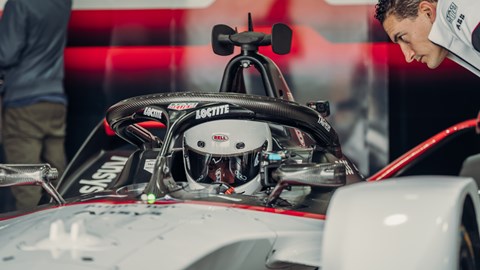
To find out if this is undeserved, we headed over to the Circuit Mallorca for a go in Porsche’s Gen 2 Formula E car – one that’s never been driven by anyone outside of the team before. It may be a few years old now (Formula E is now on Gen 3 cars from 2022), but the Spark SRT 05e is still a properly quick racing car produced with the involvement of the legendary Dallara Group.
What are the headline figures?
Brace yourself, because if you’re expecting the numbers to read like an F1 car’s then prepare for disappointment. In fact, the 99X Gen 2 Porsche Formula E car doesn’t even compare that favourably to a Taycan Turbo when it comes to power. The single-seater uses a 54kWh control battery (made by McLaren Applied Technologies) with power rated at a maximum of 335bhp.
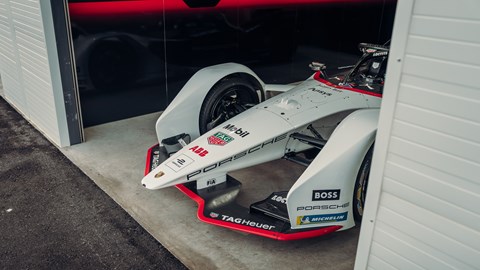
However, because the 99X weighs in at far less than most EVs (900kg including the driver, of which nearly 400kg is the battery), its straightline performance is eye-opening: 0-62mph takes less than 3 seconds while top speed is rated at 174mph. Again, not Formula 1 levels of performance – but quick enough to outperform many petrol-powered racers.
What is it like to drive?
Climbing into the 99X, it feels every bit the bona fide single-seater racing car. From the tight cockpit hemming you in (apparently I have the same body shape as Porsche Formula E test driver André Lotterer – see last pic), to the Halo that sits above your head and bisects your vision, the unusual exterior design is quickly forgotten.
I’m also mindful to take the correct procedure when climbing in and out of the car given the potential for an open-charge circuit. There’s a light display to confirm when the car is indeed safe to touch, yet I’m still cautious.
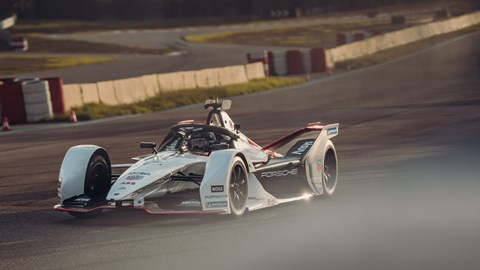
Firing the 99X up is noisier than you’d expect, too. It’s still whisper-quiet compared to ICE vehicles, yet there’s a discernible drone when it’s primed and ready to go. With a nod from engineer Kyle Wilson-Clarke, I pull out of the garage in one smooth motion, the whine of the motors increasing in pitch as the speed climbs towards the pit limiter.
Curiously, it feels far less intimidating than almost every other racing car I’ve driven. Maybe it’s the lack of noise or the Michelin Pilot Sport control tyres (far more forgiving and with a much lower limit of grip than slicks), but I’m struggling to get my head around this as a top-level motorsports car…
I don’t feel like that for long. Not 10 seconds later, when I’ve got my arms crossed to catch a slide out of the first corner – that lack of sound really lulls you into a false sense of security. The torque delivery is razor-sharp and almost instantaneous – the twist sent through the rear wheels with modest tyres and no traction control to help me out. It’s very precise however and easy enough to gather if you’re quick to respond.
Cue a full-throttle blast down the back straight and the surge of smooth, linear power is deeply impressive and, again, very different to an ICE single-seater. There are no gears, no peak in the revs, just a surge that starts off with an instant kick in the back, levels off, then surprises you again as it keeps pulling past the point where your mind is expecting a gearchange.
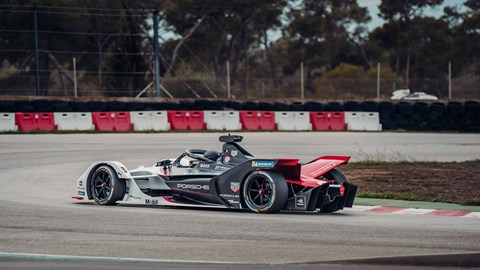
Coming into the first of many hairpins at this circuit, the Brembo carbon brakes are powerful and deliver surprising feel given the obvious regen that’s happening as a result of the deceleration.
It’s clear from the push at the front end that a) Porsche has put the car on a fairly safe set-up (I don’t blame them) and b) there’s value in really trailing the brakes deep into the corner to keep weight over the nose and get the car rotating. Then, using the oceans of low-down torque, you can power out and nail the exit with steering as unwound as possible (even a little lock can cause the rear to step out under load on a dry track).
Even from my short test session, I could feel that the 99X is a very physical car to drive. Not uncommon for a single-seater, but again perhaps not what you might expect. The look and sound almost gives Formula E racers a remote-control car-like impression on the TV, yet the reality is something far more capable and no less fun.
Verdict
Formula E’s popularity hinges on the quality of the racing and the spectacle for the audience. Of course, the cars are central to this and while replays and onboards from the series may not be as dramatic as those from other ICE-based championships, the experience from behind the wheel reveals a fun, workable racing car. Perhaps the biggest compliment I can give it, is that the 99X feels like a larger, more powerful electric go-kart – and nobody has ever complained about the racing standard in those.
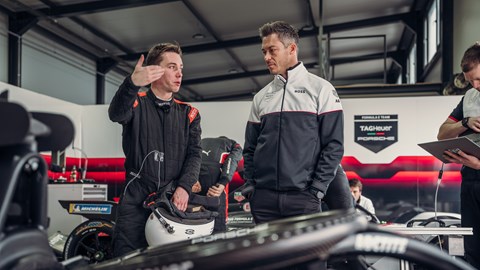
Speaking to one of the lead engineers at the Porsche Formula E team, he explained there are also huge advantages to be gained from the set-up of the chassis and powertrain – more so than in ICE racing. In such a tightly controlled series, it really can genuinely make or break a race weekend.
The challenge for Formula E, then, is to better communicate not just the technical achievements within the car and any given set-up, but also to showcase its abilities as a multi-layered – and genuinely enjoyable to drive – racing car that requires technique and skill to get the best out of its unique platform. Minus the sound of roaring racing cars, the basic ingredients are there to be showcased.